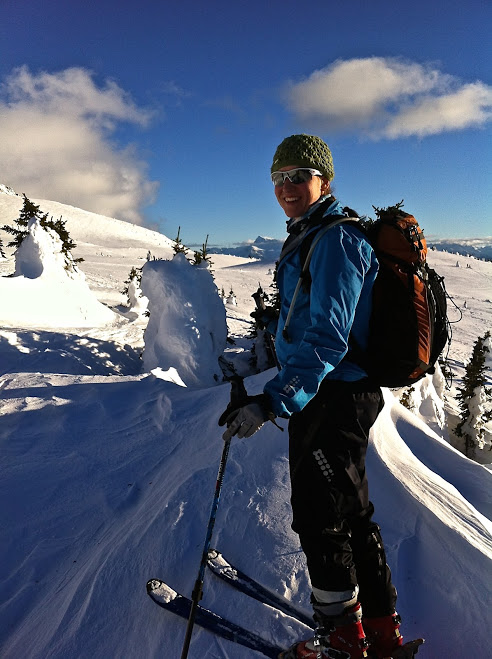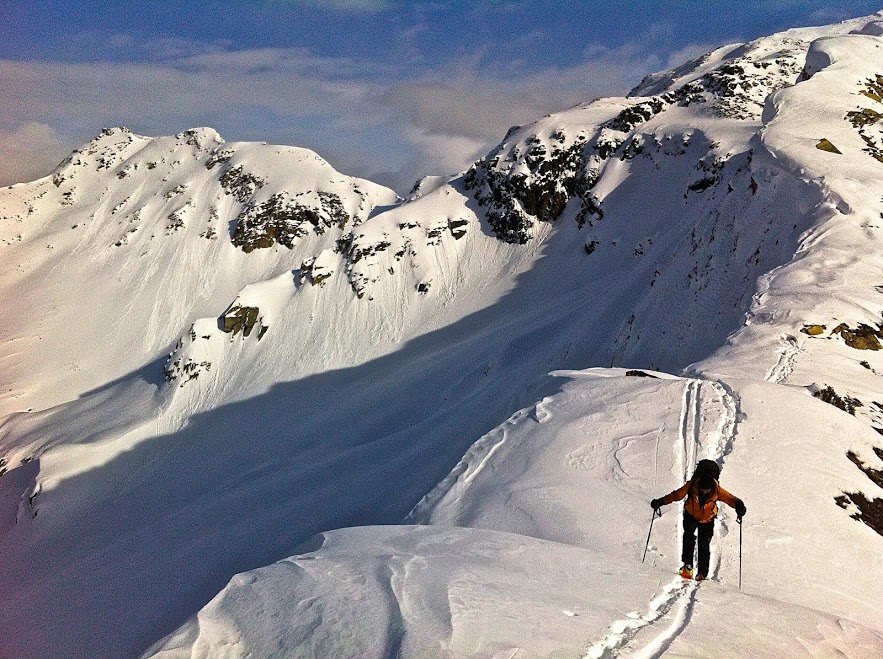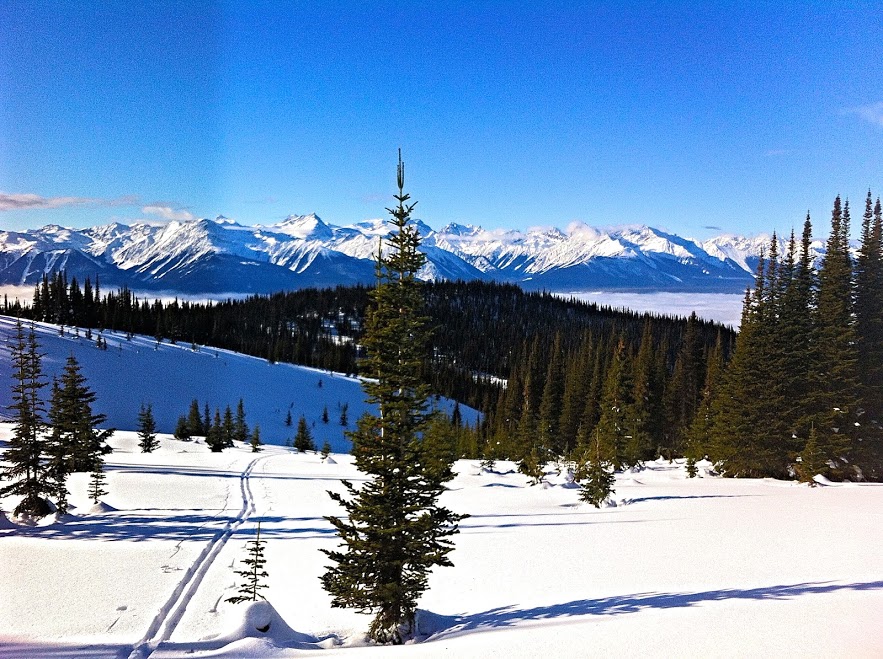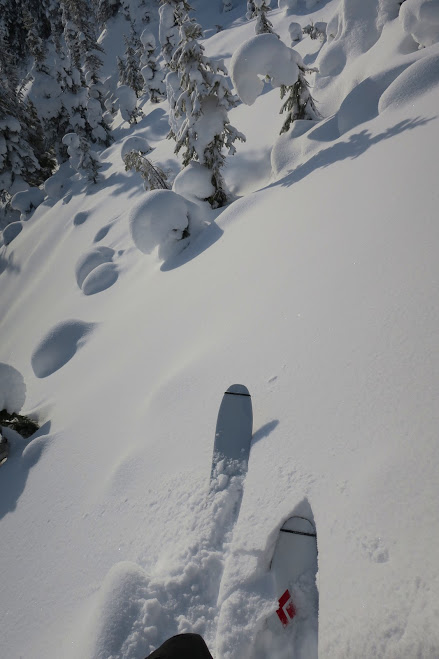Swish, click, swish, click. My bindings creak as my skis push through the soft new powder snow one step at a time. The world around me is blanketed in white, the tops of small conifers bowed under the load of accumulated snow. The muffled silence of the calm February day is broken by the rhythmic compression of my skis on the fresh snow as I step my way up the mountain, one foot in front of the other.
 Jean Ann enjoying her backyard mountain playground.
Jean Ann enjoying her backyard mountain playground.
I am on my way up to McKirdy Meadows, along the same trail I grew up hiking as a child. My first trip is still a memorable day of herding my Aunt and Grandfather’s herd of sheep up to the meadow to graze for the summer. The signs still read “McKirdy Sheep Trail”, although sheep no longer roam it. Back then we started right from the barn, at my Grandparents’ house in the valley bottom at 800m. By the end of the day we were 1200m higher up, in the cool heather and grass of the alpine meadow. It was an arduous trip for a 10-year-old, and keeping the sheep on track was a good distraction to keep me on a forward and upward trajectory.
 There’s nothing like getting above the clouds – especially in winter when daylight is already scarce.
There’s nothing like getting above the clouds – especially in winter when daylight is already scarce.
Today I left from the same location at my Grandparents’ old house where I now live. I take the back route through the forest, creating my own trail instead of climbing the gravel road, and then connect to the old sheep trail a few kilometres above by my Aunt and Uncle’s house. The trail is much improved; my Aunt now runs a cabin retreat up the mountain and the trail is well used. I only have to break through the fresh snow fallen overnight. It is easy going with a packed trail beneath my skis, light day-pack, and a consistent but moderate grade.
A few hours after leaving the house, I am past the cabin and up at the top of the meadow. On my way, I have walked up through the clouds. The valley bottom lies hidden below under a field of white. The sky is the brightest hue of blue, and the sun shines bright on the white snow. I can see across from my perch in the Rockies to the Caribou and Monashee Mountains. Through a gap in the clouds I see Kinbasket Lake, the headwaters of the Columbia River drainage. Behind me, Mount Robson, the tallest peak in the Canadian Rockies, stands out above the other peaks, with the headwaters of the Fraser River running concealed at its base.
While I am still warm from the hike up, I pull my climbing skins of my skis and stash them in my jacket where they can dry. Then I layer on the down, zip up vents, and pull on warm gloves and a hat. After a sip of tea and a snack, it is time to enjoy a some turns in the fresh powder. The light new snow on a solid base creates the perfect skiing conditions for my lightweight touring skis. I can connect turns with ease in the untracked snow, and dance side to side down the meadow leaving a squiggly track that will be erased with tomorrow’s new snow.
I spend as much of the winter as I can in the mountains on skis. When I moved back to my hometown of Valemount, B.C., I went from a year-round bike riding lifestyle on the province’s mild South Coast to a solid six months of snowbound winter. I don’t enjoy riding the indoor trainer, and the amount of outdoor running I can do is limited. I wanted something that would take me outside into the mountains that has those same elements of adventure, exploration, fitness and fun downtime as mountain biking does. So I reclaimed my old touring skis and have not looked back since.
By now I have upgraded to some lighter mountaineering skis and boots, taken part in avalanche education classes, and figured out the nuances of winter gear management. I am a bit better on the descents, but by no means good. It is mostly the uphills where I spend my time. I ski to get outside in the mountains, and see the beautiful places in my expansive mountain backyard. Staying in shape and hitting the mountain bike season with good fitness is a part of it. However, in skiing and mountain biking alike, my primary motivator is the intrinsic enjoyment of spending time outside, experiencing the beauty of the mountains, and having some fun on the trip back home.
Winter Activities for the Snowbound Cyclist
While backcountry skiing is my favorite way to get outside in the winter, it is not a reality for every day, or a possibility for everyone. I look forward to those few multi-day trips I do a year, and try to get out on weekends, even if it is close to home. But during the week, limited daylight and a regular work week put some constraints on training options. This is where I use running, a Crossfit style “Boot-Camp”, strength training, and a couple short indoor trainer sessions a week to stay fit. Winter can be a time to work on other areas fitness, address weaknesses, and refresh your mind so that you hit the spring cycling season fresh, motivated and ready to roll.
 Jean Ann logs a lot of winter aerobic fitness training on skis.
Jean Ann logs a lot of winter aerobic fitness training on skis.
Here are a few ideas for changing up your winter cycling routine and embracing the cold weather:
Backcountry Skiing – this is my preferred choice for getting out, but it does require that you live in a suitable location, have specific gear, a buddy to go with, and some knowledge of avalanche terrain. If you already downhill ski, and you live in an area near snow covered mountains, this is an option worth exploring. Check out skintrack.com for info on ski mountaneering, gear, training, and competitions. Some ski and sports-stores rent backcountry ski gear, such as MEC, which can be a good option to test out the sport before committing to buying gear. Go with someone who is experienced to start, and take an AST Level 1 course to learn about avalanche terrain and how to stay safe in the mountains. Avalanche.ca is the website of the Canadian Avalanche Association, and has avalanche forecasts and educational information.
 Cross-country skiing is another awesome way to stay fit in winter.
Cross-country skiing is another awesome way to stay fit in winter.
XC Skiing – this is another great option for gaining fitness in the winter months. There are two types of XC skiing, classic and skate. Classic skiing uses a set track, with grooves for each ski and the motion is similar to walking or running. Skate skiing is a little more challenging, but also potentially faster. It requires an open groomed trail, and the motion is a skating motion. If you are a beginner, expect a very good workout! Check out your local XC ski area to get started, many offer discounted rentals with a lesson, or night passes which can be convenient for after work.
Snowshoeing – Many ski areas (both XC and Downhill) also maintain a network of packed snowshoe trails and offer snowshoe rentals. This is a great way to try out snowshoeing, as you aren’t likely to get lost or wander into avalanche terrain. If you want to get more adventurous, you can explore some of your local summer hiking trails on snowshoes. They are relatively affordable, or can be rented at some sports-stores, such as MEC. Plus, snowshoeing is as easy as walking, so you don’t have to deal with a big learning curve to have fun. If you choose to venture into the mountains, be aware of avalanche risks associated with the area. Avalanche.ca is the website of the Canadian Avalanche Association, and has avalanche forecasts and educational information.
Indoor Cycling – There are many types of indoor cycling to choose from when the weather outside is too icy. If you live near an indoor velodrome or have access to spin classes, both are great options. At home you can make the indoor trainer or rollers a little more entertaining by watching a cycling workout video, signing up for Zwift, or just watching your favorite show, movie or cycling coverage replays. I often watch the UCI Mountain Bike World Cup on Red Bull TV to get inspired for race season.
Strength and Fitness – With Crossfit, boot camps and personal training classes popping up everywhere, there are a wealth of options available at local gyms. I like classes that incorporate a variety of strength exercises along with some good cardio. Strength and cross training are useful for addressing weaknesses that sometimes get left by the wayside in a bike centered lifestyle. Use this time to work on those weaknesses, and prevent injuries.
Yoga – This is a great way to address core strength and flexibility weaknesses. You can take a class through a local yoga studio or recreation centre, or just use a video to do it at home.
Running or Hiking – I have yet to find an activity that is as convenient, accessible and affordable as running. This is a great go-to activity for when you are time-crunched, or limited by cash, terrain, or daylight hours. To avoid injury, plan some transition time in starting with small runs and building up as your body becomes adapted. If your joints don’t handle running well, hiking is lower impact and can be a great way to get a workout in and get outdoors too. Pick an uphill route to make it a little more challenging, or carry some weight in a pack or as weights on your ankles. Tip: Yaktrax or similar lightweight “crampon” type additions to your athletic shoes or hiking boots can extend your safe running/hiking options in snowy or icy terrain by providing added traction.
Fat Bike – If you just can’t get enough time on the bike and you are snowbound for a good chunk of the year, you might want to consider a fat bike. The wide tires on these bikes give some flotation and grip in snow and sand, and provide a way to get out pedaling in the snow. Some areas maintain fat bike specific groomed trails, and fat bike events are popping up all over Canada. They also work well on packed snowmobile trails and in light snow.
Swimming – This is a crazy-good whole body workout and a great option if you have an injury, as it’s very low-impact.
Local options – Check out nearby facilities, like skating clubs, swimming pools, indoor recreational sports leagues, etc.
Things to remember when choosing any physical activity to maximize your enjoyment and chances of sticking with it:
1) Keep it Fun – your enjoyment, ability to improve, and consistency will be greatly increased if you look forward to and enjoy your physical activity.
2) Build in transition time – any change in movement, especially in the case of running and strength training, is going to be a different strain on your body. Build some transition time in early on, to allow your body to get used to different movements and build the strength needed to avoid injury. Starting small with new activities, will prevent injuries and soreness.
3) Use the resources you have available – consider what is available in your community and what kind of outdoor terrain and facilities are available locally. Work with what you have, and avoid the necessity of long drives to access your recreation. Convenience can be the deciding factor on whether or not you will get out after a long day at work.
 Jean Ann is a former Canadian Mountain Bike Team member & multi national champion. She now teaches high school & lives with her husband in Valemount, B.C., where she makes the most of her mountainous backyard, whether it’s on skis in winter or two wheels in summer. She is a proud Liv Vancouver ambassador & racer & enjoys sharing her love of cycling with others.
Jean Ann is a former Canadian Mountain Bike Team member & multi national champion. She now teaches high school & lives with her husband in Valemount, B.C., where she makes the most of her mountainous backyard, whether it’s on skis in winter or two wheels in summer. She is a proud Liv Vancouver ambassador & racer & enjoys sharing her love of cycling with others.


